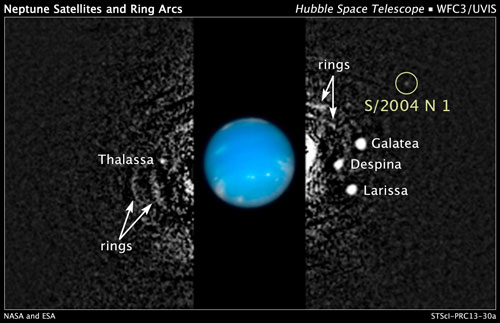| Jul 15, 2013 |
Hubble finds new Neptune moon
|
|
(Nanowerk News) NASA's Hubble Space Telescope has discovered a new moon orbiting the distant blue-green planet Neptune. This brings the number of known satellites circling the giant planet to 14.
|
|
The body is estimated to be no more than 12 miles across, making it the smallest known moon in the Neptunian system. It's so small that it escaped detection by NASA's Voyager 2 spacecraft, which flew by Neptune in 1989 and surveyed the planet's system of moons and rings.
|
 |
| This composite Hubble Space Telescope picture shows the location of a newly discovered moon, designated S/2004 N 1, orbiting the giant planet Neptune, nearly 3 billion miles from Earth. The moon is so small (no more than 12 miles across) and dim, it was missed by NASA's Voyager 2 spacecraft cameras when the probe flew by Neptune in 1989. Several other moons that were discovered by Voyager appear in this 2009 image, along with a circumplanetary structure known as ring arcs. Mark Showalter of the SETI Institute discovered S/2004 N 1 in July 2013. He analyzed over 150 archival Neptune photographs taken by Hubble from 2004 to 2009. The same white dot appeared over and over again. He then plotted a circular orbit for the moon, which completes one revolution around Neptune every 23 hours. The black-and-white image was taken in 2009 with Hubble's Wide Field Camera 3 in visible light. Hubble took the color inset of Neptune on August 19, 2009.
|
|
Mark Showalter of the SETI Institute in Mountain View, Calif., discovered the moon on July 1, while studying the faint ring-arcs of Neptune. "The moons and arcs orbit very quickly, so we had to devise a way to follow their motion in order to bring out the details of the system," he said. "It's the same reason a sports photographer tracks a running athlete -- the athlete stays in focus, but the background blurs."
|
|
On a whim, Showalter extended his analysis outward to regions well beyond the ring system, and noticed an extra white dot about 65,400 miles from Neptune, located between the orbits of the moons Larissa and Proteus.
|
|
Showalter next analyzed over 150 archival Neptune photographs taken by Hubble from 2004 to 2009. The same white dot appeared over and over again. He then plotted a circular orbit for the moon, which completes one revolution around Neptune every 23 hours.
|
|
The moon, designated S/2004 N 1, is so small and dim that it is roughly one hundred million times fainter than the faintest star that can be seen with the naked eye.
|
|
Neptune's largest moon, Triton, which is nearly the size of Earth's moon, may be a captured icy dwarf planet from the Kuiper Belt at the outer rim of our solar system. This capture would have gravitationally torn up any original satellite system Neptune possessed. Many of the moons now seen orbiting the planet probably formed after Triton settled into its unusual retrograde orbit about Neptune.
|

